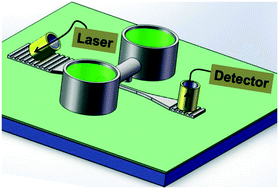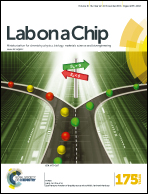Integrative optofluidic microcavity with tubular channels and coupled waveguides via two-photon polymerization†
Abstract
Miniaturization of functional devices and systems demands new design and fabrication approaches for lab-on-a-chip application and optical integrative systems. By using a direct laser writing (DLW) technique based on two-photon polymerization (TPP), a highly integrative optofluidic refractometer is fabricated and demonstrated based on tubular optical microcavities coupled with waveguides. Such tubular devices can support high quality factor (Q-factor) up to 3600 via fiber taper coupling. Microtubes with various diameters and wall thicknesses are constructed with optimized writing direction and conditions. Under a liquid-in-tube sensing configuration, a maximal sensitivity of 390 nm per refractive index unit (RIU) is achieved with subwavelength wall thickness (0.5 μm), which offers a detection limit of the devices in the order of 10−5 RIU. Such tubular microcavities with coupled waveguides underneath present excellent optofluidic sensing performance, which proves that TPP technology can integrate more functions or devices on a chip in one-step formation.


 Please wait while we load your content...
Please wait while we load your content...